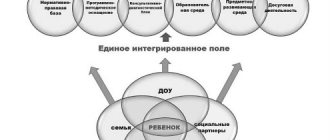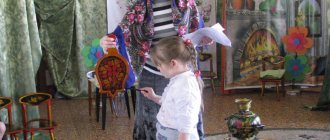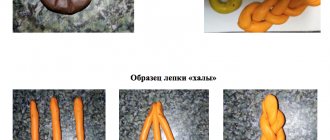Author: Syrova Larisa Anatolyevna
Purpose:
To expand and clarify children’s ideas about dishes, qualities, properties, purpose and functions.
Tasks:
- Expand and systematize children’s knowledge about dishes and their meaning in human life.
- To develop the ability to distinguish and name items of tableware and kitchen utensils.
- Develop the ability to classify utensils according to the material from which they are made (wood, metal, glass).
- Expand your vocabulary on the topic “Dishes”, learn to select and correctly repeat new words.
- Cultivate neatness and careful handling of utensils.
- Develop aesthetic perception and creative abilities.
- Introduce table manners.
- To give parents the opportunity to be active participants in the lives of children in kindergarten.
Stages of work:
Preparatory stage:
- Selection of material on the topic of the educational event.
- Selection and production of didactic games.
- Selection of illustrations and objects on the topic for carrying out productive activities together with children and designing an exhibition.
- Prepare material and information for parents.
Main stage:
- Conversations with children: “How we have breakfast and lunch,” “Helpers in the kitchen,” “How mom prepared lunch.”
- Direct educational activity “Objects around us “Dishes”.
- Excursion to the kitchen of the kindergarten (with the whole group in the kindergarten), excursion to the kitchenware store (individual visit to the children with their parents).
- Reading works of art, designing a thematic exhibition, library for parents
(K. Chukovsky “Fedorino’s grief”, “Fly - Tsokotukha”, Russian folk tale “Three Bears”, “The Fox and the Crane”, N. Nosov “Mishkina Porridge”).
- Speech games: “Tell me what I’m doing”, “Choose a word”, “Find out and name”, “Repeat after me”
- Thematic role-playing games “Home”, “Meeting guests”, “Cookware store”, “Cook”, “Family”, “Chauffeur”,
- Game situations: “Let’s help the doll set the table”, “Let’s help the mother bunny arrange the dishes”, “Let’s help the doll give tea to the guests”
- Productive activities:
Drawing: “Let’s draw beautiful dishes for the Dwarves”, “Painting plates”, “Let’s decorate beautiful plates as a gift for toys” Modeling: “Making dishes”, “Tea pair for toys” Applique: Frieze “Tea and tableware”
- Joint work activity “Washing doll dishes”
- Observation of the work of adults “The cook in the kindergarten makes compote”, “The nanny sets the table, clears the tables, washes the dishes”
- Watching cartoons “Fedorino’s grief”, “Mishkina porridge”.
- Didactic games: “Match a cup to a saucer”, “Assemble a picture from parts”, Lotto “Dishes”, “Help the three bears”.
- Working with parents: selecting pictures for the frieze, making a page for the shared book “World of Crockery,” photographs for the exhibition “What kind of dishes I have at home.”
The final stage:
- Group holiday - entertainment "Dishes".
- Designing the book “The World of Crockery” together with children.
- Designing a table setting algorithm for children.
- “We will, we will love and respect the dishes”, a joint entertainment with parents.
- Posting a photo report on the website in the “Our Beloved Children” group.
Final entertainment “Dishes” - Unusual guests came to us today, listen to them tell about themselves (children with masks on their heads ask riddles): There is a boss on the stove with pots. Fat, long-nosed... ( Kettle)
Cooks porridge, soup for Yulia And my name is... (
Casserole)
Soup, salad, mashed potatoes, cutlets Always served in... (
Plate)
Among the spoons I am a colonel And my name is... (
Ladle)
Who told the cup I I made you some tea!
( Teapot)
Every time he greets guests with delicious tea!
( Cup)
Well, do you recognize us all?
We are dishes – simply classy! Moms and dads helped us organize the exhibition. And we saw how many different dishes there are (the teacher shows, the children name). Yes, these are all dishes, they can be: Kitchen
- we cook food in it,
And dining room - we eat from it. And now I propose to play the game “Find the kitchen and tableware.” We know that dishes need to be taken care of. When we grow up, we will be good helpers, but for now we have learned finger gymnastics. I invite our parents to learn how to do it with us. We wash the dishes, wash them, we wash the dishes three, three, We love the dishes very much, We will never break them! We learned how to handle utensils made from various materials and now we will play the game “Do’s and Don’ts”. We studied dishes. We learned a lot of new things. Come visit us. We will tell you about it! Dance-game “Such different dishes.”
Detailed summary of the educational event
-Goal: Discussion of the topic in a small group. Analysis of the situation. Preparation of a mini-presentation based on a common opinion.-Materials: Whatman paper (poster), markers, felt-tip pens, computer with Internet access, mathematical encyclopedias, textbooks.
-Preliminary preparation: On each sheet of whatman paper the name of the stop is signed (“The third is not superfluous”, “Girlfriend-straight”, “Twin numerators”, “Twin denominators”, “Without a whole-nowhere”) and the main points that the groups must be filled in during work (name of the comparison method, rule, example of application, advantages, disadvantages of the method).
-Technology: All participants are divided into five groups. To do this, at the entrance to the class before the start of the lesson, they took a figure of a certain color that they liked (there are five types of figures in five colors in total; grouping can be done by both shape and color). Each group gathers at its own stop, marked with the same color. After a joint discussion and relying on the “cheat sheets” prepared at home and other sources of information, students fill out one item on the poster. (2 min.) Next, the groups move to the next stop clockwise, read the items completed before them, discuss and fill out the next item ( You cannot correct entries made by other groups). Each group must visit all stops
-This method allows, without distracting children from the educational process, to perform a small physical warm-up. To do this, it is enough to install tables for groups at different ends of the office, as far from each other as possible. It is advisable to place excess furniture around the edges of the office. The method allows the teacher to check the availability of homework during the lesson, and the students to realize the need to complete it (cheat sheets prepared at home are very helpful); allows students to search for information in various sources if necessary. The teacher should not impose his opinion on any of the groups or negatively evaluate individual statements of students. Its task is to help, if necessary, distribute roles within the group, and mathematically correctly formulate the thoughts expressed by students.
-Purpose: presentation of the results of the work of small groups.
-Materials: Whatman paper (poster), markers, felt-tip pens.
-Technology: After each group returns to the starting stop and checks all the points on their poster (at this stage, changes are allowed), a general discussion is organized. A group representative presents a poster, presents the main material, and, if necessary, answers questions from the class (approximately 3 minutes each group).
— When presenting posters, the teacher also tries to refrain from judging, allowing the students themselves to comment on the results of each group’s work.



